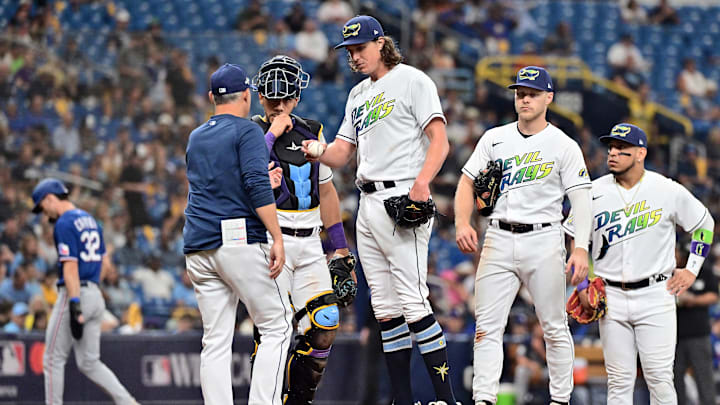Here is the dirty little secret about starting pitching that St. Louis Cardinals fans need to remember: Every single starter the Cardinals could acquire this offseason carries high levels of risk.
Every. Single. Starting. Pitcher.
It doesn't matter who your "favorite' starter is, they all carry risk. I'm super bullish on guys like Yoshinobu Yamamoto, Tyler Glasnow, and Sonny Gray. You may be super high on Dylan Cease, Aaron Nola, or Blake Snell. It doesn't matter if you're a Logan Gilbert kind of person, a Shane Bieber truther, or a believer in the Lucas Giolito experience. Let me say it again, they are all risky propositions.
I am not saying the Cardinals should avoid signing or trading for a top starting pitcher because of that. Frankly, it's still true even when we talk about names like Alek Manaoh, who the Cardinals have been linked to recently, Michael Wacha, or any other "lower-tier" starter available. That's kind of the nature of starting pitching in today's game.
Think about guys like Manoah and Cease. They were both top Cy Young candidates just a year ago and looked to be ascending talents, and both fell off from that form in under a year. Cease should still be viewed as a top starter, but it goes to show how even the top starters in baseball can fluctuate any given year.
Someone like Glasnow is going to be criticized for his injury history, and rightfully so. Sure, he's probably more likely to get injured than other guys on this list, but any name you throw out there is just one pitch away from blowing out their elbow and missing the next 12-18 months, or one bad day away from nagging shoulder issues.
Tom Verducci had an excellent story on this back in September for Sports Illustrated. Pitchers who were 25 and under last year were on pace to throw the second-fewest number of innings in a full season since 1961, with the fewest coming from pitchers in that demographic during the 2022 season. And yet, the number of starting pitchers who ended up on the injured list has doubled over the last eight years.
One of the selling points of a guy like Nola is his durability. Sure, I'd say that about him too, but there is no way for us to know if that will stay the case over the course of his next contract. Odds are, he hits the injured list multiple times and even has a major injury in there at some point.
The Tampa Bay Rays had an excellent pitching staff this past year but had Glasnow, Shane McClanahan, Jeffrey Springs, Drew Rasmussen, Shane Baz, and Andrew Kittredge all experience major injuries at some point. The Los Angeles Dodgers saw significant time missed from Clayton Kershaw, Walker Buehler, Julio Urias, Tony Gonsolin, and Dustin May. Go up and down Major League Baseball and you'll find so many pitching staff decimated by injury.
It's not just the injuries either. Players regress or underperform after signing big contracts. You may give up the next great Major Leaguer in a trade for a starting pitcher. As much as I love Yamamoto and believe he'll be incredible in the Major Leagues, you just don't know how it will look until he's actually pitching in big league games.
The price to acquire each starting pitcher should matter in this conversation as well. If you're signing Nola to a five or six-year contract this offseason, you're doing so realizing that the back end of that deal may not age very well. You're handing out $25m-$30m a year annually to a pitcher who may be past his prime, hoping to squeeze out a few more great years knowing it'll justify the back end of that contract.
Compare that to trading for a Glasnow. He'll cost you $25m this year (although the Rays may eat some of that deal), and then you are not locked into anything beyond that. The trade package required to get Glasnow is about as low of a price as you can get for a talent like him, and if things do not work out, you attach a qualifying offer to him at the end of the year and recoup that value.
When you compare the risk between these two players, you have to take into account the fact you're paying Nola number one starter money in 2028 in order to acquire him, while Glasnow you really get to take a one-year approach with him. The risk goes beyond just 2024 with Nola, while Glasnow gives you multiple outs if need be.
What's the point of this conversation? Yes, there are some guys who offer more risk to the Cardinals this offseason than others, but overall, the Cardinals should be chasing guys who can offer them high-end performance, rather than settling for the perceived "safer" options at every turn. For example, it's scary to think Glasnow could have a season-ending injury or hit the injured list for injuries multiple times next year, but the potential he offers (and the price it'll take to get him) makes him worth that risk.
I would much rather see the Cardinals go out and make aggressive moves with risk baked into them than swing low for "safe" choices, or part with young bats like Nolan Gorman or Brendan Donovan for a younger, high-upside option than the part with smaller pieces for a Glasnow or a Bieber type.
So the next time you hop on Twitter/X/Facebook and tell someone that "player X is too risky but player Y would solve all of their issues", just remember how volatile pitching really is.
